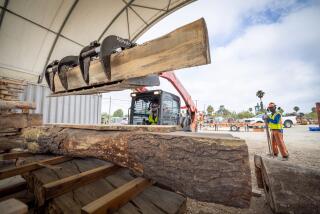Holiday Tradition on the Decline
- Share via
VALLEY PARK, Mo. — Joe Lingle isn’t ashamed to admit it.
He has worked 16 hours a day, every day since Thanksgiving, selling 8-foot firs and 10-foot pines and the dream of a Hallmark-perfect moment: Kids stringing popcorn, Mom and Dad draping tinsel, the crisp aroma of a fresh green Christmas tree wafting from the corner.
But when his own kids start begging him to get the house ready for Santa, Lingle trudges down to the basement and dusts off a box.
“With an artificial tree, I know where everything’s supposed to go. You just pull it out, put it together, and boom -- there’s your tree. You don’t have to mess with the stand or cutting the branches,” Lingle said this week as he waited for last-minute customers at the Tree Lot in this middle-class suburb of St. Louis.
His kids, who are 3 and 6, don’t complain. As long as there’s room for presents, Lingle said, “it doesn’t make much difference to them.”
More and more Americans apparently agree.
In 1990, half of all trees on display in U.S. households were real. By last year, that figure was down to 30%. Americans bought 12 million fewer live trees last year than they had a decade earlier; that amounts to a one-third drop in sales.
Final figures for this year are not in, but the anecdotal evidence looks grim: In Hawaii, lots were still so full Tuesday that vendors were giving trees away. In Texas, for the first time, the official tree of the state House of Representatives was fake -- and made in China.
And here in eastern Missouri, greenhouse owner John Loyet said with a sigh that his cut-tree sales were down, again, after years of steady slippage. He could think of only one explanation: “People are getting tired of the real deal.”
With worry verging on panic, tree growers are planning a counteroffensive.
The National Christmas Tree Assn., which represents farmers from every corner of the country, just picked up a $55,000 federal grant to study “ways to improve the product and make consumers feel good about real trees,” said Pam Helmsing, the group’s associate director.
Not willing to wait for the study’s results, however, growers hope to raise $1 million for a promotional effort next fall, possibly including radio or TV ads, said Irwin Loiterstein, who heads the association’s market expansion committee.
“You take it for granted that everyone knows what a Christmas tree is, but they don’t,” Loiterstein said. “We’re ready to take this to the next level.”
Fake-tree buyers cite all sorts of reasons for abandoning the fresh-cut tradition: Real trees are too expensive, too heavy, too messy. They’re dangerous. They’re wasteful. They make guests sneeze.
Plus, the pre-lighted, fiber-optic, flame-retardant, hypoallergenic, full-warranty synthetic models now available look so wonderfully ... real.
“I got my artificial tree a few years ago, and I love it. It’s nothing like the hideously ugly silver one we had when I was growing up,” said Karen Eigenseher, out shopping for ornaments earlier this week. “I get compliments on it every year,” she said. “I see no reason to go back.”
To win over consumers like Eigenseher, tree growers plan to hit three themes hard.
First, they hope to assure shoppers -- perhaps by hanging tags on each tree -- that buying a real Douglas fir is not a selfish, environment-depleting act. They plan to explain that Christmas trees are a crop, planted to be cut, just like corn or wheat. The trees mature for up to a dozen years, providing wildlife habitat, before they’re harvested. And as soon as one is chopped down for the holidays, another is planted in its place.
At a Seasonal Concepts store crammed with synthetic trees priced from $60 to $600, shopper Glenda Moss listened patiently to the pro-environment pitch. Her husband, she said, had nixed real trees a few years back because he hated the idea of cutting down a young pine for a few weeks’ decoration. She doubted he would be won over by the growers’ sales talk.
“No,” she said, “I don’t think it would make a difference.”
Then, with a sheepish grin, she added: “Besides, artificial trees come pre-lit now. I like the convenience.”
That’s probably the argument that growers hear most -- and the one that’s hardest to counter.
As the second prong of their promotional effort, they plan to emphasize service at tree lots, to try to make hauling home real trees less arduous.
At Big John’s, a chain of 19 tree lots in Atlanta, that concept is catching on in a big way. Matt Bowman, who manages the flagship lot, tells customers he’ll bring the tree right to their living room for $65. “We’ll move the furniture, clean up the pine needles -- whatever needs to be done,” he said.
Once he has set the tree in its stand and watered it, Bowman will string it with lights for a few hundred dollars more. After New Year’s, he’ll come by and truck it off to the recycling yard for $25. Bowman estimates he does a dozen deliveries a day, every day from Thanksgiving through mid-December.
Other growers are trying to improve convenience by offering mail-order trees. Hal Gimlin, the owner of Omni Tree Farms in North Carolina, sells 3,000 trees a year by catalog and over the Internet, shipping them as far as California and Hawaii -- for a postage fee of $12 to $350, depending on the distance and the size of the tree.
But Gimlin argues that convenience will only go so far in expanding the live-tree market. He’d prefer to see the association focus on its third, and fuzziest, goal: promoting live Christmas trees as a family bonding experience, a back-to-the-basics ritual that cuts through the commercialism of the season.
“If you spend an hour or two at the tree lot and another two or three hours of quality time decorating, the entertainment value of that tree is one of the best deals out there,” he said.
That makes sense to Roger Blackwell, a marketing professor at The Ohio State University who has advised the Christmas Tree Assn.
Blackwell likens live trees to Cracker Jack: Forty years ago, everyone loved it. But no one bothered to sell each new generation on them, so they slowly fell out of favor as flashier novelties hit the market.
“We have to do something to help people develop that emotional attachment” to live trees again, Blackwell said.
He suggests marketing techniques like one he noted the other day when he took his granddaughter to pick out a tree. The lot had a Santa on hand to greet the kids. It even offered a sleigh ride. And workers tied the tree on his car with an easy-to-untie bow. With those amenities, picking out a tree “became an enriching experience,” not just another holiday chore, Blackwell said.
Lynn Freese, a teacher in suburban St. Louis, knows the feeling. She briefly flirted with a synthetic tree. But family tradition had too strong a hold. “There’s just something special about a real tree,” she said. “There are enough artificial things in the world today. It’s nice to have something real.”
More to Read
Inside the business of entertainment
The Wide Shot brings you news, analysis and insights on everything from streaming wars to production — and what it all means for the future.
You may occasionally receive promotional content from the Los Angeles Times.










